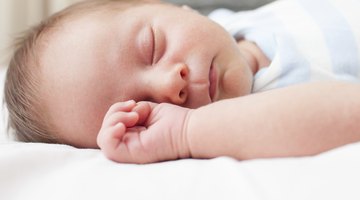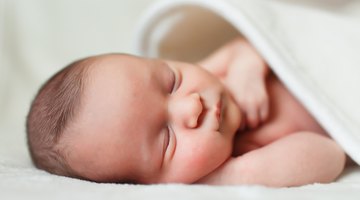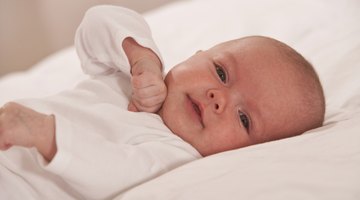The 6 Behavioral States of a Newborn
A newborn's behavioral state comes from one of his six states of consciousness. These states include two sleep states, three awake states and one transitional state. Your newborn’s facial expression and body movement vary within each state, but newborns who have healthy nervous systems instinctively and smoothly transition from one state to the next.
Quiet Sleep
"Quiet sleep," also called "deep sleep," occurs when your newborn is most relaxed. Your baby's eyelids remain closed and still, and he remains relatively unresponsive to outside noise. He may stir some, but very little. According to Heidi Murkoff in "What to Expect the First Year," your newborn alternates between quiet and active sleep every 30 minutes.
Active Sleep

Positions of Babies During the Seventh Month of Pregnancy
Learn More
During "active sleep," sudden noises can startle your newborn awake. His eyes move rapidly beneath closed lids and may even flutter open before quickly closing again. Your newborn's arms and legs twitch and jolt, and he may also move his mouth around, making sucking or chewing movements and other funny faces.
Quiet Alert
Newborns in the "quiet alert" state make small, infrequent movements, if any at all. The eyes remain open wide in watchful awareness. Marshall H. Klaus and Phyllis H. Klaus, authors of "Your Amazing Newborn," explain that newborns in the "quiet alert" state "can follow a red ball, gaze at a face, turn to a voice" and even begin imitating facial expressions. Your baby may seem subdued in this state, but he is actually very busy learning about the world around him.
Active Alert

Infant Noises in Sleep
Learn More
Newborns reach the peak of movement during the "active alert" state. They move with purpose, rhythmically stretching their arms and kicking their legs. This movement reinforces the connection between your baby's brain and body muscles. Your baby's eyes also frequently dart around during this state, and he may make small "cooing" sounds. Mild fussing occurs within this state as well.
Active Crying
Within the "active crying" state, your newborn's movements switch from rhythmic to chaotic. His eyes shut, his face twists and his arms and legs flail around. Your baby cries when he feels hunger, discomfort, frustration or loneliness. According to Klaus and Klaus, picking up your newborn within 90 seconds after he enters the crying state typically switches him to the "quiet alert" state. The movement involved in transitioning from lying flat to resting upright distracts and calms most babies.
Drowsiness
Drowsiness occurs as a transition between the alert and sleep states. As newborns wake up or fall asleep, they enter the drowsy state. Your baby may make a few bodily movements, such as stretching, as well as a range of facial expressions -- from scowling to smiling to yawning. His eyelids always begin drooping in this state, however, and his eyes take on a glazed, unfocused look.
Related Articles
- MedlinePlus: Infant Newborn Development; January 2011
- Mesa Community College: Infant States and Temperment
- Healthy Chldren: States of Consciousness in Newborns; May 2011
- "Your Amazing Newborn"; Marshall H. Klaus, et al.; 1998
- "What to Expect the First Year;" Heidi Murkoff, et al.; 2008











